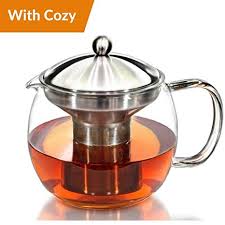How To Choose A Tea Pot For Your Tea
What is the difference between a Tea Kettle And A Teapot. They both look sort of similar with a spout and a lid, they both have names which include the word tea, and they both contain hot water at some point in the tea making process.

When making tea using a teapot, you should have both a teapot and a tea kettle. A kettle is what you use to heat the water. You then pour the heated water into the teapot. The leaves should go in the teapot. The teapot is for steeping the tea. The leaves do not go in the tea kettle. The teapot should not go on the stove.
Types Of Tea Pots
Porcelain
White clay pots first appeared at Jingdezhen and the best was known as qingbai or yingqing (clear bluish-white). Then came quingei (made in Longquan) which first appeared during the 7th century and used wood ash and iron in the clay fired in an oxygen-reduced atmosphere. In English, quingei became celadon; Korea, Thailand, Japan, and China all still make pots with this glistening greenish-gray glaze.
Glass
Glass pots can stain and a little elbow grease, with or without mild soap, will clean them up easily and completely. If soap is used, it is critical to rinse in very warm water (thoroughly, many times) to ensure that no soap residue remains. Check for the manufacturer�s instructions whether the pot is dishwasher safe. Two caveats: Never put a hot teapot in a freezer or refrigerator and never put it directly on a gas or electric stove, because it might crack. Some manufacturers make complementary warming stands which use small tea candles that can keep the tea hot. Tea cozies are always suitable.
Ceramic
Ceramic teapots were commonly fired in open pits, and originated 11,000 years ago in Asia and the Middle East for everyday use. Clay and earthenware pots then, and now, have natural heat-retention properties, low seepage, and brew the leaves quickly. We suggest using a timer for the first pot or two, then adjusting your brewing times according to your taste. Note the spout and if it narrows slightly at the end; this indicates better pouring capability than a too-wide opening in the spout. Check the inside of your ceramic teapot for glazing. If it is glazed, you can certainly alternate your tea choices; if unglazed or if it is an Yixing pot, stick to one type of tea only. Like ancient times, ceramic and earthenware clay pots are fired at low temperatures.
Choosing A Tea Pot
1.. Cast Iron Tea Pot
Cast iron teapots retain and maintain heat for a long time. They were originally used to hold hot water. Cast iron is good for all tea types because it infuses evenly. The only downside is the rim can develop rust overtime. You can clean rust by rubbing a used tea leaf in the rusted area.
2. Yixing Tea Pot
Yixing teapots are best for oolong and pu erh teas. They are recommended for single sourced and unflavored teas such as Art of Tea’s Ti Kuan Yin or Pu-erh Tuo Cha. Over time and usage, minerals and oils from the yixing influence the flavors of the tea. In fact, the teapot becomes denser after each use, so you can eventually steep tea shorter because the flavors are already absorbed within the walls of the yixing. Each yixing must only be used for one tea because the interior of the pot is unglazed. If you steep Orchid Oolong, you should always make that tea in that yixing.
3. Glass Tea Pot
Glass teapots such as the Glass Assam Tea Press or Glass Bell Teapot retain heat evenly. Since it is transparent, you can watch the tea leaves unfurl and determine by color when to stop steeping. This is the ideal pot for blooming teas but great for all tea types, so you can see the leaves unravel and flowers blossom. However, because glass is so delicate, it is prone to breakage and may stain on the spout. To prevent breaking, it is recommended to hand wash. Quality glass teapots are lead free and made of borosilicate glass like the Glass Assam teapots by Bodum.
4. Ceramic Tea Pot
Ceramic teapots like the Bell Teapot by For Life are perfect for all tea types. Ceramic teapots are sturdy and easy to clean for food service. Since the inside is coated or glazed, this teapot is easier to clean and doesn’t impact the flavor of the tea. Ceramic pots also retain heat well, so they will keep tea warm for a longer period of time.
Tips For Choosing A Tea Pot
- Does the vessel look appealing? Often, part of the comfort and pleasure of drinking tea is in the preparation and use of a favorite pot, with it’s plump curves and solid lines.
- You will want a teapot that is made of hard, dense clay or other materials that will hold heat. Tap the pot with your finger and listen for a sharp, solid sound.
- Check the fit of the lid. Your pot will have a vent on the lid, which should fit so tightly that when you cover the vent no liquid will pour from the spout.
- Of course, the flow from the spout is important. (What’s worse than a dribbling teapot!) Since it’s not usually practical to test a pot with liquid before you buy it, check that the top of the spout is level with the top of the pot. More oval shaped spouts are less likely to drip than rounded ones.
The handle of a good teapot should be well positioned. When you lift a pot that is filled to capacity, there should be little-to-no strain to your wrist. Also, the handle should be wide enough that your knuckles don’t get burnt against the pot.There should be enough distance between the spout and the top of the teapot so your hand doesn’t get scalded with steam when holding the lid in place as you pour the tea.
